最新安徽省高考英语试题及答案
2020年普通高等学校招生全国统一考试英语试题(安徽卷,解析版)(2)
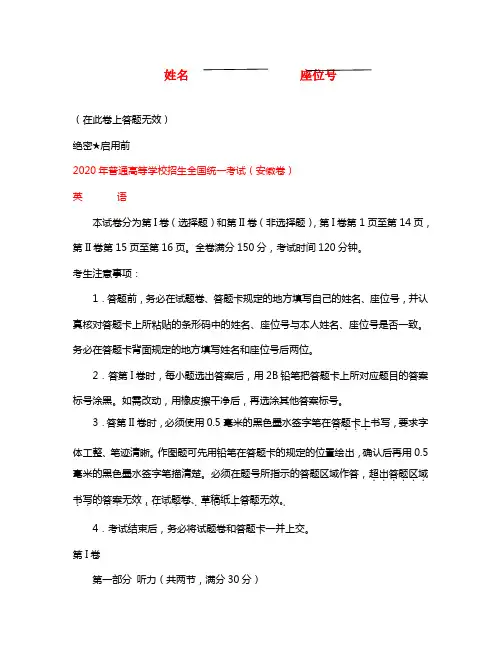
姓名座位号(在此卷上答题无效)绝密★启用前2020年普通高等学校招生全国统一考试(安徽卷)英语本试卷分为第I卷(选择题)和第II卷(非选择题),第I卷第1页至第14页,第II卷第15页至第16页。
全卷满分150分,考试时间120分钟。
考生注意事项:1.答题前,务必在试题卷、答题卡规定的地方填写自己的姓名、座位号,并认真核对答题卡上所粘贴的条形码中的姓名、座位号与本人姓名、座位号是否一致。
务必在答题卡背面规定的地方填写姓名和座位号后两位。
2.答第I卷时,每小题选出答案后,用2B铅笔把答题卡上所对应题目的答案标号涂黑。
如需改动,用橡皮擦干净后,再选涂其他答案标号。
3.答第II卷时,必须使用0.5毫米的黑色墨水签字笔在答题卡上书写,要求字....体工整、笔迹清晰。
作图题可先用铅笔在答题卡的规定的位置绘出,确认后再用0.5毫米的黑色墨水签字笔描清楚。
必须在题号所指示的答题区域作答,超出答题区域......书写的答案无效,在试题卷、草稿纸上答题无效。
......................4.考试结束后,务必将试题卷和答题卡一并上交。
第I卷第一部分听力(共两节,满分30分)做题时,先将答案标在试卷上,录音内容结束后,你将有两分钟的时间将试卷上的答案转涂到答题卡上。
第一节(共5小题;每小题1.5分,满分7.5分)听下面5段对话,每段对话后有一个小题,从题中所给的A、B、C三个选项中选出最佳选项,并标在试卷的相应位置。
听完每段对话后,你都有10秒钟的时间来回答有关小题和阅读下一小题,每段对话仅读一遍。
例:How much is the shirt?A. £19.15B. £9.18C. £9.15答案是C1.What does the man want to do?A.Take photosB.Boy a cameraC.Help the woman2.What are the speakers talking about?A.A noisy nightB.Their life in townC.A place of living3.Where is the man now?A.On his wayB.In a restaurantC.At home4.What will Celia do?A.Find a playerB.Watch a gameC.Play basketball5.What day is it when the conversation takes place?A.SaturdayB.SundayC.Monday第二节(共15小题;每小题1.5分,满分22.5分)听下面5段对话或独白,每段对话或独白后有几个小题,从题中所给的A、B、C三个选项中选出最佳选项,并标在试卷的相应位置。
2024年安徽高考英语真题及答案
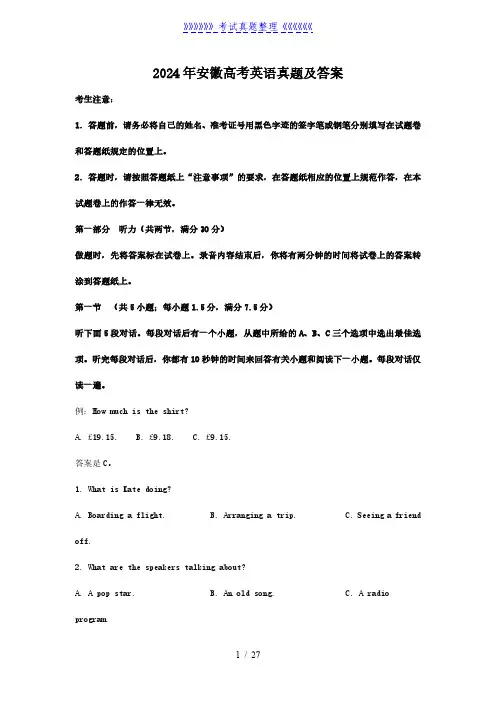
2024年安徽高考英语真题及答案考生注意:1.答题前,请务必将自己的姓名、准考证号用黑色字迹的签字笔或钢笔分别填写在试题卷和答题纸规定的位置上。
2.答题时,请按照答题纸上“注意事项”的要求,在答题纸相应的位置上规范作答,在本试题卷上的作答一律无效。
第一部分听力(共两节,满分30分)做题时,先将答案标在试卷上。
录音内容结束后,你将有两分钟的时间将试卷上的答案转涂到答题纸上。
第一节(共5小题;每小题1.5分,满分7.5分)听下面5段对话。
每段对话后有一个小题,从题中所给的A、B、C三个选项中选出最佳选项。
听完每段对话后,你都有10秒钟的时间来回答有关小题和阅读下一小题。
每段对话仅读一遍。
例:How much is the shirt?A.£19.15.B.£9.18.C.£9.15.答案是C。
1.What is Kate doing?A.Boarding a flight.B.Arranging a trip.C.Seeing a friend off.2.What are the speakers talking about?A.A pop star.B.An old song.C.A radio program.3.What will the speakers do today?A.Go to an art show.B.Meet the man's aunt.C.Eat out with Mark.4.What does the man want to do?A.Cancel an order.B.Ask for a receipt.C.Reschedule a delivery.5.When will the next train to Bedford leave?A.At9:45.B.At10:15.C.At11:00.第二节(共15小题;每小题1.5分,满分22.5分)听下面5段对话或独白。
安徽2024高考英语试卷
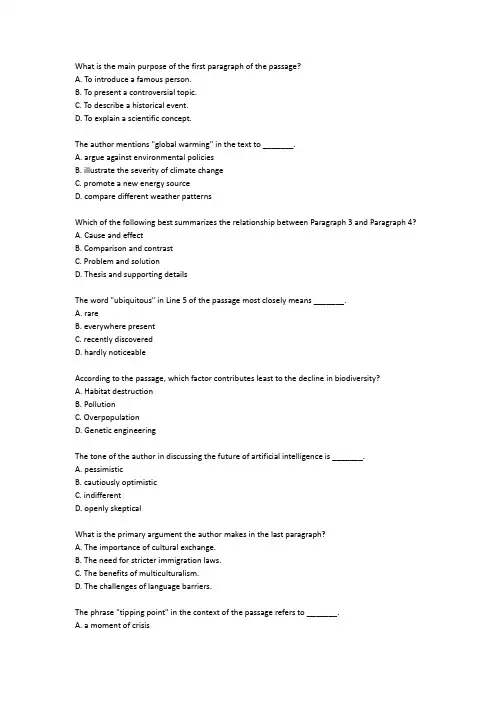
What is the main purpose of the first paragraph of the passage?A. To introduce a famous person.B. To present a controversial topic.C. To describe a historical event.D. To explain a scientific concept.The author mentions "global warming" in the text to _______.A. argue against environmental policiesB. illustrate the severity of climate changeC. promote a new energy sourceD. compare different weather patternsWhich of the following best summarizes the relationship between Paragraph 3 and Paragraph 4?A. Cause and effectB. Comparison and contrastC. Problem and solutionD. Thesis and supporting detailsThe word "ubiquitous" in Line 5 of the passage most closely means _______.A. rareB. everywhere presentC. recently discoveredD. hardly noticeableAccording to the passage, which factor contributes least to the decline in biodiversity?A. Habitat destructionB. PollutionC. OverpopulationD. Genetic engineeringThe tone of the author in discussing the future of artificial intelligence is _______.A. pessimisticB. cautiously optimisticC. indifferentD. openly skepticalWhat is the primary argument the author makes in the last paragraph?A. The importance of cultural exchange.B. The need for stricter immigration laws.C. The benefits of multiculturalism.D. The challenges of language barriers.The phrase "tipping point" in the context of the passage refers to _______.A. a moment of crisisB. a point of no returnC. a minor inconvenienceD. a temporary setbackWhich of the following statements about the character in the story is NOT true?A. She was born into a wealthy family.B. She faced numerous challenges in life.C. She eventually achieved her dreams.D. She never received any support from others.。
2020年普通高等学校招生全国统一考试英语试题(安徽卷,解析版)
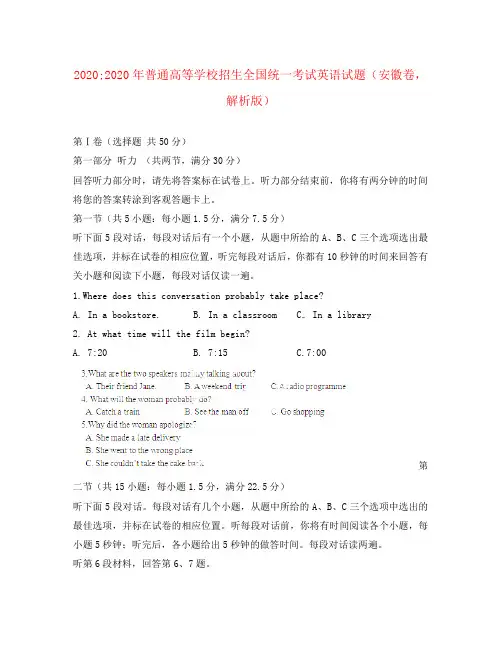
2020;2020年普通高等学校招生全国统一考试英语试题(安徽卷,解析版)第Ⅰ卷(选择题共50分)第一部分听力(共两节,满分30分)回答听力部分时,请先将答案标在试卷上。
听力部分结束前,你将有两分钟的时间将您的答案转涂到客观答题卡上。
第一节(共5小题:每小题1.5分,满分7.5分)听下面5段对话,每段对话后有一个小题,从题中所给的A、B、C三个选项选出最佳选项,并标在试卷的相应位置,听完每段对话后,你都有10秒钟的时间来回答有关小题和阅读下小题,每段对话仅读一遍。
1.Where does this conversation probably take place?A. In a bookstore.B. In a classroomC. In a library2. At what time will the film begin?A. 7:20B. 7:15C.7:00第二节(共15小题:每小题1.5分,满分22.5分)听下面5段对话。
每段对话有几个小题,从题中所给的A、B、C三个选项中选出的最佳选项,并标在试卷的相应位置。
听每段对话前,你将有时间阅读各个小题,每小题5秒钟;听完后,各小题给出5秒钟的做答时间。
每段对话读两遍。
听第6段材料,回答第6、7题。
6.Whose CD is broken?A.Kathy’sB. Mum’sC. Jack’s7.What dose the boy promise to do for the girl?A. Buy her new CD.B. Do some cleaning.C. Give her 10 dollars.听第7段材料,回答第8、9题。
8.What did the man think of the meal?A. Just so-so.B. Quite satisfactoryC.A bit disappointing.9. What was the 15% on the bill paid for ?A. The foodB. The drinksC. The service.听第8段材料,回答第10至12题。
普通高等学校招生全国统一英语考试(安徽卷)_附答案
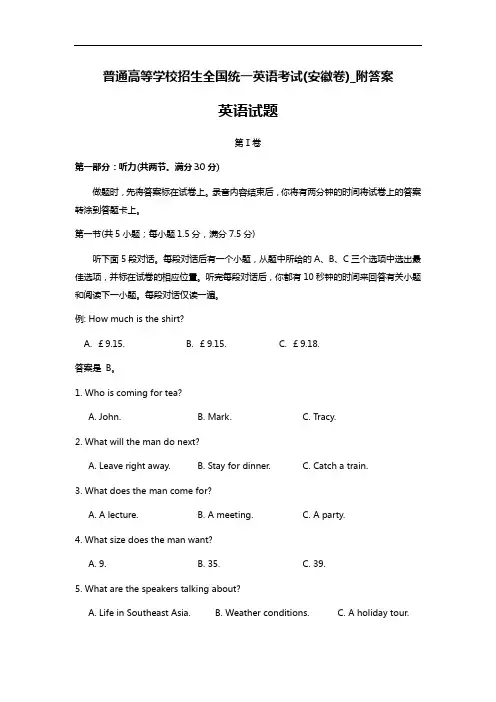
普通高等学校招生全国统一英语考试(安徽卷)_附答案英语试题第Ⅰ卷第一部分:听力(共两节。
满分30分)做题时,先将答案标在试卷上。
录音内容结束后,你将有两分钟的时间将试卷上的答案转涂到答题卡上。
第一节(共5小题;每小题1.5分,满分7.5分)听下面5段对话。
每段对话后有一个小题,从题中所给的A、B、C三个选项中选出最佳选项,并标在试卷的相应位置。
听完每段对话后,你都有10秒钟的时间来回答有关小题和阅读下一小题。
每段对话仅读一遍。
例: How much is the shirt?A. £9.15.B. £9.15.C. £9.18.答案是B。
1. Who is coming for tea?A. John.B. Mark.C. Tracy.2. What will the man do next?A. Leave right away.B. Stay for dinner.C. Catch a train.3. What does the man come for?A. A lecture.B. A meeting.C. A party.4. What size does the man want?A. 9.B. 35.C. 39.5. What are the speakers talking about?A. Life in Southeast Asia.B. Weather conditions.C. A holiday tour.第二节(共15小题;每小题1.5分,满分22.5分)听下面5段对话。
每段对话后有几个小题,从题中所给的A、B、C三个选项中选出最佳选项,并标在试卷的相应位置。
听每段对话前,你将有时间阅读各个小题,每小题5秒钟;听完后,各小题将给出5秒钟的作答时间。
每段对话读两遍。
听第6段材料,回答第6、7题。
6. What is the man doing?A. Giving a speech.B. Chairing a meeting.C. Introducing a person.7. Why does the woman sing so well?A. She has a great teacher.B. She teaches singing.C. She is young.听第7段材料,回答第8、9题。
2023年安徽高考英语真题及答案
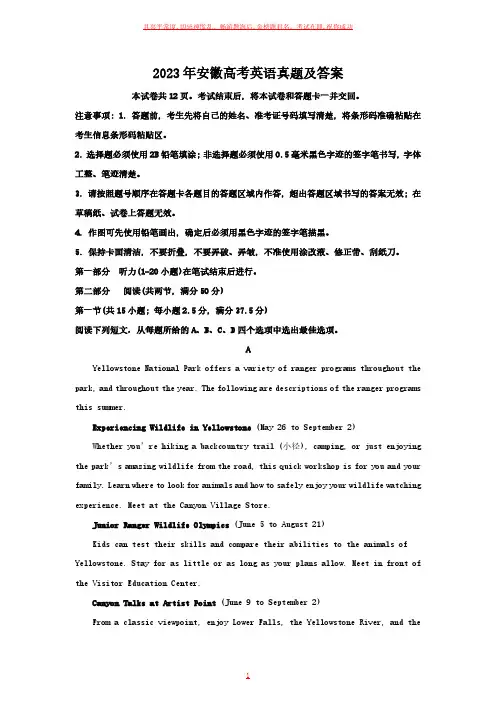
2023年安徽高考英语真题及答案本试卷共12页。
考试结束后, 将本试卷和答题卡一并交回。
注意事项: 1. 答题前, 考生先将自己的姓名、准考证号码填写清楚, 将条形码准确粘贴在考生信息条形码粘贴区。
2. 选择题必须使用2B铅笔填涂; 非选择题必须使用0.5毫米黑色字迹的签字笔书写, 字体工整、笔迹清楚。
3. 请按照题号顺序在答题卡各题目的答题区域内作答, 超出答题区域书写的答案无效; 在草稿纸、试卷上答题无效。
4. 作图可先使用铅笔画出, 确定后必须用黑色字迹的签字笔描黑。
5. 保持卡面清洁, 不要折叠, 不要弄破、弄皱, 不准使用涂改液、修正带、刮纸刀。
第一部分听力(1-20小题)在笔试结束后进行。
第二部分阅读(共两节, 满分50分)第一节(共15小题; 每小题2.5分, 满分37.5分)阅读下列短文,从每题所给的A、B、C、D四个选项中选出最佳选项。
AYellowstone National Park offers a variety of ranger programs throughout the park, and throughout the year. The following are descriptions of the ranger programs this summer.Experiencing Wildlife in Yellowstone (May 26 to September 2)Whether you’re hiking a backcountry trail (小径), camping, or just enjoying the park’s amazing wildlife from the road, this quick workshop is for you and your family. Learn where to look for animals and how to safely enjoy your wildlife watching experience. Meet at the Canyon Village Store.Junior Ranger Wildlife Olympics (June 5 to August 21)Kids can test their skills and compare their abilities to the animals of Yellowstone. Stay for as little or as long as your plans allow. Meet in front of the Visitor Education Center.Canyon Talks at Artist Point (June 9 to September 2)From a classic viewpoint, enjoy Lower Falls, the Yellowstone River, and thebreathtaking colors of the canyon (峡谷) while learning about the area’s natural and human history. Discover why artists and photographers continue to be drawn to this special place. Meet on the lower platform at Artist Point on the South Rim Drive for this short talk.Photography Workshops (June 19 &July 10)Enhance your photography skills — join Yellowstone’s park photographer for a hands-on program to inspire new and creative ways of enjoying the beauty and wonder of Yellowstone.6/19 — Waterfalls &Wide Angles: meet at Artist Point.7/10 — Wildflowers &White Balance: meet at Washburn Trailhead in Chittenden parking area.1. Which of the four programs begins the earliest?A. Photography Workshops.B. Junior Ranger Wildlife Olympics.C. Canyon Talks at Artist Point.D. Experiencing Wildlife in Yellowstone.2. What is the short talk at Artist Point about?A. Works of famous artists.B. Protection of wild animals.C. Basic photography skills.D. History of the canyon area.3. Where will the participants meet for the July 10 photography workshop?A. Artist Point.B. Washburn Trailhead.C. Canyon Village Store.D. Visitor Education Center.BTurning soil, pulling weeds, and harvesting cabbage sound like tough work for middle and high school kids. And at first it is, says Abby Jaramillo, who with another teacher started Urban Sprouts, a school garden program at four low-income schools. The program aims to help students develop science skills, environmental awareness, and healthy lifestyles.Jaramillo’s students live in neighborhoods where fresh food and green space are not easy to find and fast food restaurants outnumber grocery stores. “The kidsliterally come to school with bags of snacks and large bottles of soft drinks,” she says. “They come to us thinking vegetables are awful, dirt is awful, insects are awful.” Though some are initially scared of the insects and turned off by the dirt, most are eager to try something new.Urban Sprouts’ classes, at two middle schools and two high schools, include hands-on experiments such as soil testing, flower-and-seed dissection, tastings of fresh or dried produce, and work in the garden. Several times a year, students cook the vegetables they grow, and they occasionally make salads for their entire schools.Program evaluations show that kids eat more vegetables as a result of the classes. “We have students who say they went home and talked to their parents and now they’re eating differently,” Jaramillo says.She adds that the program’s benefits go beyond nutrition. Some students get so interested in gardening that they bring home seeds to start their own vegetable gardens. Besides, working in the garden seems to have a calming effect on Jaramillo’s special education students, many of whom have emotional control issues. “They get outside,” she says, “and they feel successful.”4. What do we know about Abby Jaramillo?A. She used to be a health worker.B. She grew up in a low-income family.C. She owns a fast food restaurant.D. She is an initiator of Urban Sprouts.5. What was a problem facing Jaramillo at the start of the program?A. The kids’ parents distrusted her.B. Students had little time for her classes.C. Some kids disliked garden work.D. There was no space for school gardens.6. Which of the following best describes the impact of the program?A. Far-reaching.B. Predictable.C. Short-lived.D. Unidentifiable.7. What can be a suitable title for the text?A. Rescuing School GardensB. Experiencing Country LifeC. Growing Vegetable LoversD. Changing Local LandscapeCReading Art: Art for Book Lovers is a celebration of an everyday object — the book, represented here in almost three hundred artworks from museums around the world. The image of the reader appears throughout history, in art made long before books as we now know them came into being. In artists’ representations of books and reading, we see moments of shared humanity that go beyond culture and time.In this “book of books,” artworks are selected and arranged in a way that emphasizes these connections between different eras and cultures. We see scenes of children learning to read at home or at school, with the book as a focus for relations between the generations. Adults are portrayed (描绘) alone in many settings and poses —absorbed in a volume, deep in thought or lost in a moment of leisure. These scenes may have been painted hundreds of years ago, but they record moments we can all relate to.Books themselves may be used symbolically in paintings to demonstrate the intellect (才智), wealth or faith of the subject. Before the wide use of the printing press, books were treasured objects and could be works of art in their own right. More recently, as books have become inexpensive or even throwaway, artists have used them as the raw material for artworks — transforming covers, pages or even complete volumes into paintings and sculptures.Continued developments in communication technologies were once believed to make the printed page outdated. From a 21st-century point of view, the printed book is certainly ancient, but it remains as interactive as any battery-powered e-reader. To serve its function, a book must be activated by a user: the cover opened, the pages parted, the contents reviewed, perhaps notes written down or words underlined. And in contrast to our increasingly networked lives where the information we consume is monitored and tracked, a printed book still offers the chance of a wholly private, “off-line” activity.8. Where is the text most probably taken from?A. An introduction to a book.B. An essay on the art of writing.C. A guidebook to a museum.D. A review of modern paintings.9. What are the selected artworks about?A. Wealth and intellect.B. Home and school.C. Books and reading.D. Work and leisure.10. What do the underlined words “relate to” in paragraph 2 mean?A. Understand.B. Paint.C. Seize.D. Transform.11. What does the author want to say by mentioning the e-reader?A. The printed book is not totally out of date.B. Technology has changed the way we read.C. Our lives in the 21st century are networked.D. People now rarely have the patience to read.DAs cities balloon with growth, access to nature for people living in urban areas is becoming harder to find. If you’re lucky, there might be a pocket park near where you live, but it’s unusual to find places in a city that are relatively wild.Past research has found health and wellness benefits of nature for humans, but a new study shows that wildness in urban areas is extremely important for human well-being.The research team focused on a large urban park. They surveyed several hundred park-goers, asking them to submit a written summary online of a meaningful interaction they had with nature in the park. The researchers then examined these submissions, coding (编码) experiences into different categories. For example, one participant’s experience of “We sat and listened to the waves at the beach for a while” was assigned the categories “sitting at beach” and “listening to waves.”Across the 320 submissions, a pattern of categories the researchers call a “nature language” began to emerge. After the coding of all submissions, half adozen categories were noted most often as important to visitors. These include encountering wildlife, walking along the edge of water, and following an established trail.Naming each nature experience creates a usable language, which helps people recognize and take part in the activities that are most satisfying and meaningful to them. For example, the experience of walking along the edge of water might be satisfying for a young professional on a weekend hike in the park. Back downtown during a workday, they can enjoy a more domestic form of this interaction by walking along a fountain on their lunch break.“We’re trying to generate a language that helps bring the human-nature interactions back into our daily lives. And for that to happen, we also need to protect nature so that we can interact with it,” said Peter Kahn, a senior author of the study.12. What phenomenon does the author describe at the beginning of the text?A. Pocket parks are now popular.B. Wild nature is hard to find in cities.C. Many cities are overpopulated.D. People enjoy living close to nature.13. Why did the researchers code participant submissions into categories?A. To compare different types of park-goers.B. To explain why the park attracts tourists.C. To analyze the main features of the park.D. To find patterns in the visitors’ summaries.14. What can we learn from the example given in paragraph 5?A. Walking is the best way to gain access to nature.B. Young people are too busy to interact with nature.C. The same nature experience takes different forms.D. The nature language enhances work performance.15. What should be done before we can interact with nature according to Kahn?A. Language study.B. Environmental conservation.C. Public education.D. Intercultural communication. 第二节(共5小题; 每小题2.5分, 满分12.5分)阅读下面短文, 从短文后的选项中选出可以填入空白处的最佳选项。
高考英语试题及答案
2024高考英语试题及答案2024年高考英语试题及答案一、试题分析2024年高考英语试题整体上保持稳定,注重考查学生的语言应用能力和语境理解能力。
试题遵循《考试大纲》的要求,坚持稳中求变,变中求新的原则,充分体现了高中英语教学的成果和发展方向。
二、考点分析1.词汇语法:试题考查了词汇运用的准确性,语法的灵活性和得体性,以及在具体语境中正确运用语法知识的能力。
如选择题中对动词时态、语态及非谓语动词的考查。
2.阅读理解:阅读理解部分选取了不同类型的文章,包括社会热点、科普知识、人物传记等,旨在全面考查考生对不同文本的理解和获取信息的能力。
3.完形填空:完形填空题注重考查考生的语言感知和语境理解能力,强调词汇搭配和语法知识的运用。
通过上下文的理解,考生需要推导出空格处缺失的含义。
4.写作:写作部分要求考生根据提示,撰写一篇150词左右的短文。
题目既考查考生的语言表达能力,又考查考生的思维能力和文化素养。
三、试题答案因篇幅原因,此处只提供部分试题及答案。
1.词汇语法:选择题部分:1、动词时态:He _______ in the library every Sunday. A. worksB. workedC. has workedD. is working 答案:A2、非谓语动词:_______ a chance to study abroad, he felt very excited. A. Having given B. To give C. Giving D. Given 答案:D2.阅读理解:Part A:1、篇名:The Power of Words2、内容:本文介绍了语言的力量,以及积极的语言如何影响个人和社会。
3、问题及答案:4、Q1: What is the main idea of the article?5、A1: The power of words.6、Q2: According to the article, how can words affect us?7、A2: Positive words can inspire and uplift us, while negative words can hurt and defeat us.3.完形填空:Part B:1、篇名:The Importance of Failure2、内容:本文讲述失败的重要性,以及失败对个人成长的贡献。
安徽高考英语试题及答案
安徽高考英语试题及答案一、听力部分(共30分)1. 根据所听内容,选择正确的图片。
A. [图片1]B. [图片2]C. [图片3]D. [图片4]答案:A2. 根据对话内容,选择最佳答案。
A. 他要去图书馆。
B. 他要回家。
C. 他要去商店。
D. 他要去电影院。
答案:B3. 根据短文内容,回答以下问题。
Q1: What is the main topic of the passage?答案:The main topic is about environmental protection.Q2: What action does the speaker suggest?答案:The speaker suggests reducing the use of plastic bags.二、阅读理解(共40分)A篇:根据文章内容,选择最佳答案。
1. What is the author's opinion on the importance ofeducation?A. It is essential for personal growth.B. It is not very important.C. It is only necessary for certain professions.D. It is a waste of time.答案:A2. According to the article, what is the role of technologyin education?A. It is a distraction.B. It is an essential tool.C. It has no impact on learning.D. It is a threat to traditional teaching methods.答案:BB篇:根据文章内容,判断以下陈述是否正确。
2020年普通高等学校招生全国统一考试英语试题(安徽卷,含答案)
2020年普通高等学校招生全国统一考试英语试题(安徽卷,含答案)试卷分第Ⅰ卷(选择题)和第Ⅱ卷(非选择题)两部分,第Ⅰ卷第1页至第14页,第Ⅱ卷第15页至第16页。
全卷满分150分,考试时间120分钟。
考生注意事项:1.答题前,务必在试题卷、答题卡规定的地方填写自己的姓名、座位号,并认真核对答题卡上所粘贴的条形码中姓名、座位号与本人姓名、座位号是否一致。
务必在答题卡背面规定的地方填写姓名和座位号后两位。
2. 答第Ⅰ卷时,每小题选出答案后,用2B铅笔把答题卡上对应题目的答案标号涂黑。
如需改动,用橡皮擦干净后,再选涂其他答案标号。
3.答第Ⅱ卷时,必须使用0.5毫米的黑色墨水签字笔在答题卡上书写,要求字体工整,笔迹清晰。
作图题可先用铅笔在答题卡规定的位置绘出,确认后再用0.5毫米的黑色墨水签字笔描清楚。
务必在题号所指示的答题区域内作答,超出答题区域书写的答案无效,在试题卷、草稿纸上答题无效。
4.考试结束,务必将试题卷和答题卡一并上交。
第Ⅰ卷第一部分听力(共两节,满分30分)回答听力部分时,请先将答案标在试卷上。
听力部分结束前,你将有两分钟的时间将你的答案转涂到客观题答题卡上。
第一节(共5小题;每小题1.5分,满分7.5分)听下面5段对话。
每段对话后有一个小题,从题中所给的A、B、C三个选项中选出最佳选项,并标在试卷的相应位置。
听完每段对话后,你都有10秒钟的时间来回答有关小题和阅读下一小题。
每段对话仅读一遍。
例:How much is the shirt?A.$19.15B.$9.15C.$9.18答案是B。
1. What will Dorothy do on the weekend?A. Go out with her friend.B. Work on her paper.C. Make some plans.2. What was the normal price of the T-shirt?A.$15.B. $30.C. $50.3. What has the woman decided to do on Sunday afternoon?A. To attend a wedding.B. To visit an exhibition.C. To meet a friend.4. When does the bank close on Saturday?A. At 1:00 pm.B. At 3:00 pm.4. At 4:00 pm.5. Where are the speakers?A. In a store.B. In a classroom.C. At a hotel.第二节(共15小题;每小题1.5分,满分22.5分)听下面5段对话或独白。
安徽高三英语试题及答案
安徽高三英语试题及答案# 安徽高三英语试题及答案## 听力部分### 听力理解1. 听下面一段对话,回答下列小题。
- 1.1 What is the man going to do?A. Go to the library.B. Go to the cinema.C. Go to the concert.- 1.2 What does the woman think of the man's plan?A. She agrees with him.B. She doesn't like it.C. She has no opinion.2. 听下面一段独白,回答下列小题。
- 2.1 What is the speaker mainly talking about?A. A new book.B. A new movie.C. A new play.- 2.2 What is the main reason for the speaker's opinion?A. The plot is too complicated.B. The characters are not well-developed.C. The dialogues are not realistic.## 阅读理解### 阅读理解A阅读下面的短文,从每题所给的四个选项(A、B、C和D)中,选出最佳选项。
Passage 1The rise of technology has brought about significant changes in the way we live and work. With the advent of smartphones and the internet,we have become increasingly dependent on technology for our daily needs.3. What is the main idea of the passage?A. Technology is changing our lives.B. Smartphones are becoming more popular.C. The internet is essential for daily needs.D. We should reduce our dependence on technology.4. According to the passage, which of the following is NOT a result of technological advancements?A. Improved communication.B. Increased productivity.C. Decreased social interaction.D. More leisure time.### 阅读理解B阅读下面的短文,完成5-7题。
- 1、下载文档前请自行甄别文档内容的完整性,平台不提供额外的编辑、内容补充、找答案等附加服务。
- 2、"仅部分预览"的文档,不可在线预览部分如存在完整性等问题,可反馈申请退款(可完整预览的文档不适用该条件!)。
- 3、如文档侵犯您的权益,请联系客服反馈,我们会尽快为您处理(人工客服工作时间:9:00-18:30)。
2010年安徽卷普通高等学校招生全国统一考试英语本试卷分第Ⅰ卷(选择题)和第Ⅱ卷(非选择题)两部分,第Ⅰ卷第1页至第14页,第Ⅱ卷第15页至第16页。
全卷满分150分,考试时间120分钟。
第Ⅰ卷第一部分听力(共两节,满分30分)回答听力部分时,请先将答案标在试卷上。
听力部分结束前,你将有两分钟的时间将你的答案转涂到客观题答题卡上。
第一节(共5小题;每小题1.5分,满分7.5分)听下面5段对话。
每段对话后有一个小题,从题中所给的A、B、C三个选项中选出最佳选项,并标在试卷的相应位置。
听完每段对话后,你都有10秒钟的时间来回答有关小题和阅读下一小题。
每段对话仅读一遍。
例:How much is the shirt?A.$19.15B.$9.15C.$9.18答案是B。
1. What will Dorothy do on the weekend?A. Go out with her friend.B. Work on her paper.C. Make some plans.2. What was the normal price of the T-shirt?A.$15.B. $30.C. $50.3. What has the woman decided to do on Sunday afternoon?A. To attend a wedding.B. To visit an exhibition.C. To meet a friend.4. When does the bank close on Sunday?A. At 1:00 pm.B. At 3:00 pm.C. At 4:00 pm.5. Where are the speakers?A. In a store.B. In a classroom.C. At a hotel.第二节(共15小题;每小题1.5分,满分22.5分)听下面5段对话或独白。
每段对话或独白后有几个小题,从题中所给A、B、C三个选项中选出最佳选项,并标在试卷的相应位置。
听每段对话或独白前,你将有时间阅读各个小题,每小题5秒钟;听完后,各小题给出5秒钟的作答时间。
每段对话或独白读两遍。
听第6段材料,回答6、7题。
6. What do we know about Nora?A. She prefers a room of her own.B. She likes to work with other girls.C. She lives near the city center.7.What is good about the flat?A. It has a large sitting room.B. It has good furnitureC. It has a big kitchen听第7段材料,回答8、9题。
8.Where has Barbara been?A. MilanB. FlorenceC. Rome9.What has Barbara got in her suitcase?A. ShoesB. StonesC. Books听第8段材料,回答第10至12题。
10. Who is making the telephone call?A. Thomas BrothersB. Mike LandonC. Jack Cooper11.What relation is the woman to Mr. Cooper?A. His wifeB. His bossC. His secretary12.What is the message about?A. A meetingB. A Visit to FranceC. The date for a trip听第9段材料,回答第13至16题。
13.Who could the man Speaker most probably be?A. A person who saw the accidentB. The driver of the lorryC. A police officer14. What was Mrs. Franks doing when the accident took place?A. Walking along Churchill AvenueB. Getting ready to cross the roadC. Standing outside a bank15.When did the accident happen?A. At about 8:00 amB. At about 9:00 amC. At about 10:00 am16. How did the accident happen?A. A lorry hit a carB. A car ran into a lorryC. A bank clerk rushed into the street听第10段材料,回答第17至20题。
17. What is the talk mainly about?A. The history of the schoolB. The courses for the termC. The plan for the day18.Where can the visitors learn about the subjects for new students?A. In the school hallB. In the science labsC. In the classrooms19.What can students in the practical areas?A. Take science coursesB. Enjoy excellent mealsC. Attend workshops20. When are the visitors expected to ask questions?A. During the lunch hourB. After the welcome speechC. Before the tour of the labs第二部分英语知识运用(共两节,满分45分)第一节单项填空(共15题;每小题1分,满分15分)从A、B、C、D四个选项中,选出可以填入空白处的最佳选项,并在答题卡上将该项涂黑例:It is generally considered unwise to give a child ___________he or she wants.A. howeverB. whateverC. whicheverD. whenever答案是B。
21. You are a team star! Workingwithis rally your cup of tea.A. bothB. eitherC. othersD. the other22. No matter how low you consider yourself, there is always someoneyou wishing they were that high.A. getting rid ofB. getting along withC.1ooking up toD. looking down upon23. —How did you like Nick’s performance last night?—To be honest, his singing didn’tto me much.A. appealB. belongC. referD. occur24.—Do you know if Linda is willing to take charge of the program?—, does it?A. It takes no timeB. It counts for nothingC. It doesn’t hurt to askD. It doesn’t, make sense25.I haven’t seen Sara since she was a little girl, and she has changed beyond.A.hearingB.strengthC.recognitionD. measure26. Bob would have helped us yesterday, but he .A.was busyB. is busy C had been busy D. will be busy27.It was from only a few supplies that she had bought in the villagethe hostess cooked such a nice dinner.A.whereB. thatC. whenD.which28. —Were you surprised by the ending of the film?—No.Ithe book,so I already knew the story.A.was readingB.had readC.am readingD. have read29.The engineers are so busy that they have zero time for outdoor sports activities, they have the interest.A.whereverB.wheneverC.even ifD.as if30. He had wonderful childhood, __________ with his mother to all corners of the word.A. travelB. to travelC. traveledD. traveling31.,she is the sort of woman to spread sunshine to people through her smileA. Shy and cautiousB. Sensitive and thoughtfulC. Honest and confidentD. Lighthearted and optimistic32. Jack described his father,whoa brave boy many years ago, as a strong-willed man.A. would beB. would have beenC. must beD. must have been33. Just use this room for the time being,and we’ll offer you a larger one it becomes availableA.as soon asB.unlessC. as far asD. until34. —We’ve spent too much money recently.—Well, it isn’t surprising. Our friends and relativesaround all the time.A. are comingB. had comeC. were comingD. have been coming35. —?—That would be great!Please drop me off at the library.A. Could you bring me the billB. Would you like me to give you a liftC. Could you tell me the postcode for ParisD. Would you like to have my e-mail address第二节完形填空(共20小题;每小题1.5分,满分30分)阅读下面短文,从短文后各题所给的四个选项中,选出可以填入空白处的最佳选项,并在答题卡上将该项涂黑。
